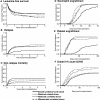Allogeneic hematopoietic cell transplantation for hematologic malignancy: relative risks and benefits of double umbilical cord blood
- PMID: 20686119
- PMCID: PMC2996124
- DOI: 10.1182/blood-2010-05-285304
Allogeneic hematopoietic cell transplantation for hematologic malignancy: relative risks and benefits of double umbilical cord blood
Abstract
Effectiveness of double umbilical cord blood (dUCB) grafts relative to conventional marrow and mobilized peripheral blood from related and unrelated donors has yet to be established. We studied 536 patients at the Fred Hutchinson Cancer Research Center and University of Minnesota with malignant disease who underwent transplantation with an human leukocyte antigen (HLA)-matched related donor (MRD, n = 204), HLA allele-matched unrelated donor (MUD, n = 152) or 1-antigen-mismatched unrelated adult donor (MMUD, n = 52) or 4-6/6 HLA matched dUCB (n = 128) graft after myeloablative conditioning. Leukemia-free survival at 5 years was similar for each donor type (dUCB 51% [95% confidence interval (CI), 41%-59%]; MRD 33% [95% CI, 26%-41%]; MUD 48% [40%-56%]; MMUD 38% [95% CI, 25%-51%]). The risk of relapse was lower in recipients of dUCB (15%, 95% CI, 9%-22%) compared with MRD (43%, 95% CI, 35%-52%), MUD (37%, 95% CI, 29%-46%) and MMUD (35%, 95% CI, 21%-48%), yet nonrelapse mortality was higher for dUCB (34%, 95% CI, 25%-42%), MRD (24% (95% CI, 17%-39%), and MUD (14%, 95% CI, 9%-20%). We conclude that leukemia-free survival after dUCB transplantation is comparable with that observed after MRD and MUD transplantation. For patients without an available HLA matched donor, the use of 2 partially HLA-matched UCB units is a suitable alternative.
Figures
References
-
- Wagner JE, Rosenthal J, Sweetman R, et al. Successful transplantation of HLA-matched and HLA-mismatched umbilical cord blood from unrelated donors: analysis of engraftment and acute graft-versus-host disease. Blood. 1996;88(3):795–802. - PubMed
-
- Kurtzberg J, Laughlin M, Graham ML, et al. Placental blood as a source of hematopoietic stem cells for transplantation into unrelated recipients. N Engl J Med. 1996;335(3):157–166. - PubMed
-
- Laughlin MJ, Barker J, Bambach B, et al. Hematopoietic engraftment and survival in adult recipients of umbilical-cord blood from unrelated donors. N Engl J Med. 2001;344(24):1815–1822. - PubMed
-
- Laughlin MJ, Eapen M, Rubinstein P, et al. Outcomes after transplantation of cord blood or bone marrow from unrelated donors in adults with leukemia. N Engl J Med. 2004;351(22):2265–2275. - PubMed
-
- Rocha V, Labopin M, Sanz G, et al. Transplants of umbilical-cord blood or bone marrow from unrelated donors in adults with acute leukemia. N Engl J Med. 2004;351(22):2276–2285. - PubMed
Publication types
MeSH terms
Substances
Grants and funding
LinkOut - more resources
Full Text Sources
Other Literature Sources
Medical
Research Materials



